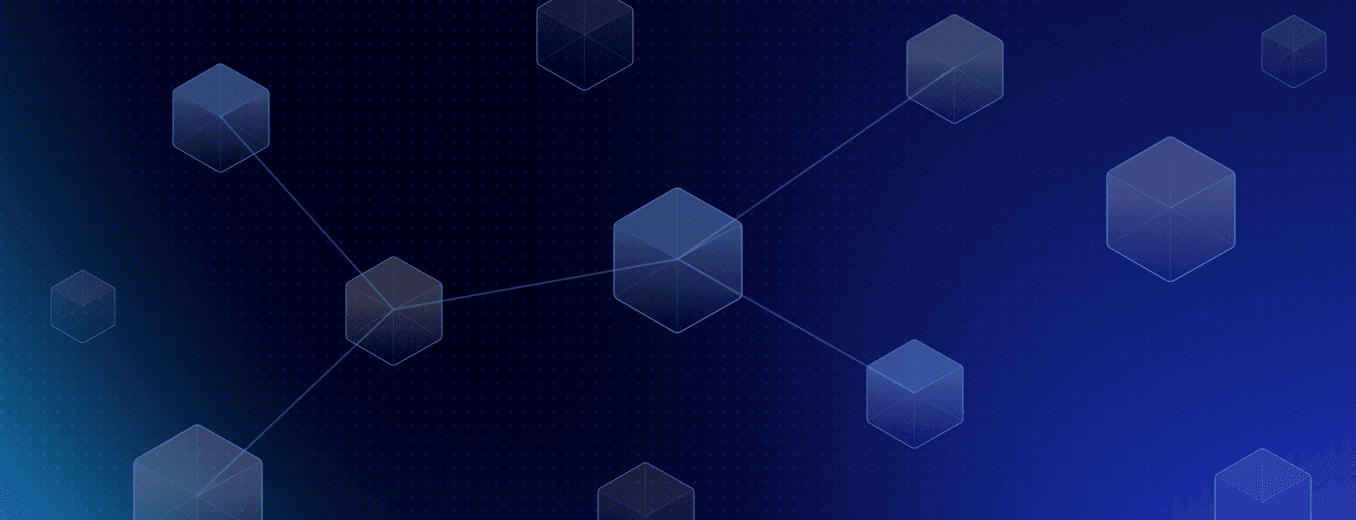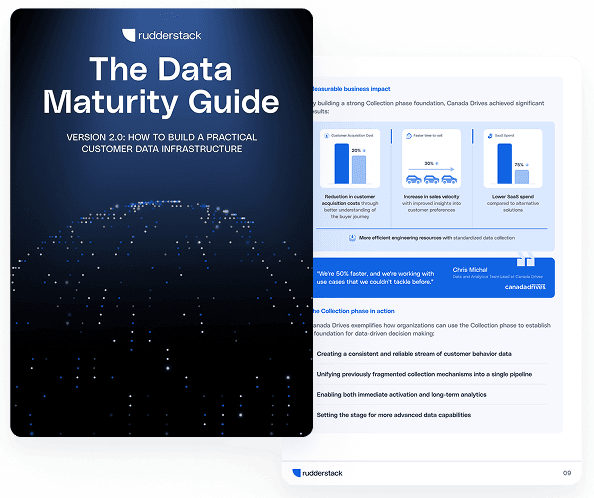Data maturity Phase 1: Build your foundation with streamlined collection

We recently posted about the roadmap to data maturity, and today’s post continues that conversation. The journey to data maturity begins with one critical step: getting your data collection right. Before you can centralize data, train models, or deliver real-time personalization, you need a reliable foundation—a unified, governed way to collect customer data across platforms.
Most companies start here, whether they're migrating from a patchwork of Google Tag Manager implementations, basic ETL jobs, manual CSV exports, point integrations, or brittle DIY pipelines that break every time someone updates the frontend.
The hidden costs of fragmented collection
Consider this scenario: Your email marketing system shows a user's last login as "user_ID: 12345" while your product analytics tool records the same person as "userID: 12345." This may seem like a subtle difference, but it breaks identity resolution across your entire stack. This inconsistency cascades through every downstream system, making it impossible to answer even basic questions like "How many active users do we have?" with confidence.
This isn't just a technical problem. It's a business problem. When different teams rely on inconsistent event names, conflicting user identifiers, or partial data sets, the impact ripples across the organization:
- Marketing teams can't accurately attribute conversions or calculate true customer acquisition costs
- Product teams make decisions based on incomplete user journey data
- Executive leadership loses trust in reporting when the same metric shows different values across dashboards
- Engineering teams spend too much of their time maintaining fragile integrations instead of building new features
Why collection comes first
Messy data early in the pipeline causes downstream chaos that becomes exponentially more expensive to fix later. The old saying "garbage in, garbage out" is particularly true for customer data, and no amount of sophisticated analytics or machine learning can compensate for fundamentally inconsistent or unreliable source data.
The Collection phase solves these core challenges by introducing a unified event data layer that addresses three critical business needs:
Data consistency: Every team works from the same standardized events and properties, eliminating the "whose numbers are right?" debates that waste hours in every meeting.
Integration simplicity: A centralized collection system streamlines pipeline management, reducing engineering overhead and ensuring reliability as you add new tools to your stack.
Real-time activation: Clean, standardized event streams enable teams to trigger personalized experiences and automated workflows based on customer behaviors as they happen.
This foundation is crucial, especially for businesses in regulated industries where inconsistent data creates not just operational headaches but compliance risks. By solving data quality issues at the source, you create infrastructure that can scale with governance controls intact.
When to invest in the Collection phase
The Collection phase is the foundation for all future data maturity efforts, but timing this investment correctly is crucial for maximizing impact. You're likely ready to invest in Collection when you recognize these patterns:
Tool proliferation symptoms:
- Marketing, product, and engineering teams have each adopted multiple SaaS tools
- Each tool requires its own custom data pipeline or integration
- New tool implementations take weeks instead of days due to data integration complexity
Data inconsistency indicators:
- The same metrics show different values across tools and dashboards
- Teams regularly spend meeting time debating whose numbers are correct
- Monthly reporting requires manual reconciliation across multiple systems
Engineering bottleneck signs:
- Your development team spends significant time maintaining custom integrations
- Implementing new tracking requirements becomes a multi-sprint project
- Engineers are constantly firefighting broken data pipelines
Compliance and governance concerns:
- Privacy regulations require more granular control over data collection and distribution
- Audit trails for customer data are fragmented across multiple systems
- Data retention and deletion policies are difficult to enforce consistently
Activation limitations:
- Teams can't respond to customer behaviors in real-time due to fragmented data flows
- Personalization initiatives are limited by inconsistent customer profiles
- Marketing automation struggles with incomplete or conflicting customer data
For startups and smaller organizations, implementing the Collection phase early creates a scalable foundation that prevents technical debt from accumulating. For larger enterprises, it's often the first step in modernizing legacy systems that have evolved organically over time.
The key indicator: When your teams spend more time debating whose numbers are correct than acting on the insights those numbers should provide, it's time to invest in a unified data collection layer.
Measurable business impact
A well-implemented collection layer transforms how your organization operates with data, delivering both immediate operational benefits and strategic advantages:
Analytics alignment: Marketing, product, and executive teams work from consistent numbers, eliminating the trust issues that slow decision-making and create organizational friction.
Engineering efficiency: Development teams reduce time spent on integration maintenance, freeing valuable engineering resources for product innovation and feature development.
Accelerated experimentation: New tools can be added to your stack in days rather than weeks, enabling faster testing of new channels, platforms, and optimization approaches.
Enhanced compliance: Centralized control over data collection creates consistent privacy standards, simplified audit trails, and the ability to implement data governance policies at scale.
Real-time customer experiences: Clean event streams enable immediate responses to customer behaviors across channels—from triggered email campaigns to in-app personalization.
Beyond these operational benefits, the Collection phase creates something invaluable: trust in your data. When teams know they're working with reliable, consistent information, they shift from defensive data validation to proactive insight generation. This cultural change often delivers value that's harder to quantify but equally important.
Perhaps most significantly, this phase sets the stage for future growth. By solving fundamental data consistency and integration challenges now, you create the infrastructure needed to support advanced use cases as your business evolves, without requiring painful re-architecting later.
Customer spotlight: Canada Drives
Canada Drives, Canada's largest 100% online car shopping platform, exemplifies how the Collection phase can transform a business facing unique data challenges.
The challenge: Unlike traditional e-commerce with frequent repeat purchases, vehicle sales involve complex, high-value customer journeys where potential buyers often research anonymously for weeks before identifying themselves. "Users don't identify themselves when they assess financing or calculate the value of a vehicle they're selling or trading in," explains Andrew Hall, VP of Data and Analytics. "We needed better analytics tools to generate actionable insights into customer behavior at every level of our admittedly steep and unique funnel."
The Collection phase solution: Canada Drives implemented RudderStack to create a unified data collection foundation:
- Standardized event tracking across all customer touchpoints
- Unified data layer connecting anonymous and known user interactions
- Real-time data activation to both analytics platforms and operational tools
- Warehouse integration with Snowflake as their source of truth
Measurable results:
- 20% reduction in customer acquisition costs through better journey understanding
- 23% decrease in inventory time-to-sell with improved customer preference insights
- 75% lower SaaS spend compared to alternative solutions
- 50% faster development cycles with standardized data collection
"We're 50% faster, and we're working with use cases that we couldn't tackle before," says Chris Michal, Data and Analytics Team Lead at Canada Drives.
The broader impact: By establishing a solid Collection phase foundation, Canada Drives didn't just solve their immediate analytics challenges—they created the infrastructure needed for their subsequent centralization in Snowflake and sophisticated ML-powered recommendation models that continue to drive business results.
Want to learn more about Canada Drives’ journey? Read the full case study
Implementation strategy: Building your collection foundation
Successfully implementing the Collection phase requires a structured approach that balances immediate value delivery with long-term scalability:
1. Establish your tracking plan and governance
- Define standard naming conventions for events, properties, and user identifiers
- Create a centralized tracking plan that documents all customer touchpoints
- Assign clear ownership for data collection standards and governance
- Implement validation rules to ensure data quality at the source
2. Implement unified event collection
- Deploy real-time streaming infrastructure to capture events from websites, mobile apps, and server-side systems
- Standardize event schemas across all sources to ensure consistency
- Build identity resolution processes to connect users across anonymous and known sessions
- Establish monitoring and alerting for data quality issues
3. Create centralized routing and activation
- Configure simultaneous data routing to your warehouse and operational tools
- Set up real-time activation capabilities for immediate customer engagement
- Implement proper data governance controls for privacy and compliance
- Create documentation and training for teams using the new infrastructure
4. Build for future scalability
- Design your collection infrastructure to handle growing data volumes
- Implement version control for tracking plans and schema changes
- Create processes for adding new data sources and destinations
- Establish regular review cycles for data quality and governance
Throughout implementation, focus on creating tight feedback loops with business teams. The most successful Collection phase implementations continuously refine data collection based on actual usage patterns and evolving business needs.
Signs you're ready for the next phase
You'll know your Collection phase implementation is successful when:
- Teams stop debating whose numbers are correct and start focusing on insights
- New tool integrations happen in days instead of weeks
- Real-time customer activation becomes routine rather than exceptional
- Engineering time shifts from maintenance to innovation
- Data governance becomes proactive rather than reactive
Once your event collection is unified, governed, and trusted across the organization, you'll naturally start hitting new limitations. Teams will begin asking questions that require data beyond just customer events—CRM records, payment information, support interactions, and other business-critical data trapped in various SaaS tools.
This is when you'll be ready to move beyond the Collection phase to Centralization: establishing a true single source of truth that combines all your customer data, not just events, into one powerful analytical foundation.
What's next
In our next post, we'll explore Phase 2: Centralization—how to move beyond streamlined collection to create a comprehensive single source of truth that combines event data with all your other customer information. We'll cover when to make this investment, implementation strategies, and how companies like InfluxData transformed their operations by centralizing their customer data infrastructure.
Ready to assess your current data maturity and plan your next steps? Download the full guide from the left side of this page or book a demo to learn more
Published:
August 14, 2025

Event streaming: What it is, how it works, and why you should use it
Event streaming allows businesses to efficiently collect and process large amounts of data in real time. It is a technique that captures and processes data as it is generated, enabling businesses to analyze data in real time

RudderStack: The essential customer data infrastructure
Learn how RudderStack's customer data infrastructure helps teams collect, govern, transform, and deliver real-time customer data across their stack—without the complexity of legacy CDPs.

Scaling data products starts with fixing the foundation: Five lessons we’ve learned
Most teams don’t have a modeling problem—they have a foundation problem. This post shows how to standardize your pipeline, put one owner in charge, and use observability to scale data products.






